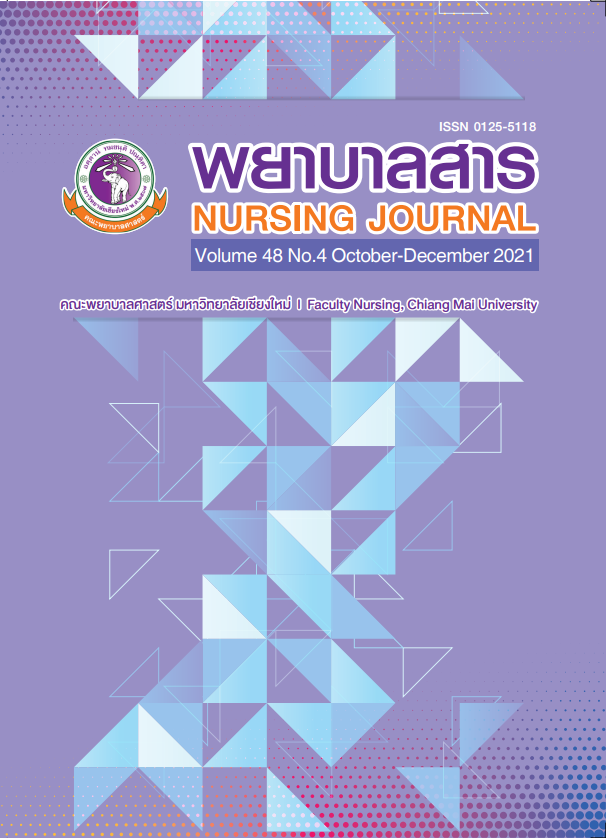The Critical and Chronic Care Nurses’ Attitudes Toward End-of-Life Care
Keywords:
attitudes toward end-of-life-care, critical care nurses, chronic care nursesAbstract
This descriptive study aimed to explore attitudes toward end-of-life care among critical and chronic care nurses in Yunnan Province, the People’s Republic of China. Purposive sampling was used to recruit 106 participants who were critical care nurses and 98 participants who were chronic care nurses from two tertiary hospitals in Yunnan from April to June, 2020. Measurement tools included a Demographic Data Record Form and the Frommelt Attitudes Toward Care of the Dying Scale, Form B, Chinese Version (FATCOD-B-C). The internal consistency of the Chinese version of the tool was checked and the Cronbach’s alpha was .81. Descriptive statistics and an independent T-test were used for data analysis. The results of this study showed that the mean scores for attitudes toward end-of-life care among critical care nurses and chronic care nurses were 95.85 (SD = 8.64) and 98.99 (SD = 7.57), respectively. Only four critical care nurses (3.77%) and three chronic care nurses (3.06%) had positive attitudes toward end-of-life care. There was a statistically significant difference between the attitudes toward end-of-life care between critical care nurses and chronic care nurses (t [202] = 0.30, p < .05). Results of this study suggests the need for conducting qualitative studies to explore Chinese nurses’ feelings toward provision of end-of-life care to understand their points of view, especially for those who have positive attitudes. The strategies used to overcome conflicts arising from formal beliefs in traditional Chinese culture should be explored.
References
Braun, M., Gordon, D., & Uziely, B. (2010). Associations between oncology nurses' attitudes toward death and caring for dying patients. Oncology Nursing Forum, 37(1), e43-e49.
Bükki, J., Neuhaus, P. M., & Paal, P. (2016). End of life care in nursing homes: Translating focus group findings into action. Geriatric Nursing, 37(6), 440-445.
Cui, J., Shen, F., Ma, X., & Zhao, J. (2011). What do nurses want to learn from death education? A survey of their needs. Oncology Nursing Forum, 38(6), e402-e408.
Dunn, K. S., Otten, C., & Stephens, E. J. (2005). Nursing experience and the care of dying patients. Oncology nursing forum, 32(1), 97-104.
Field, M. J., & Cassel, C. K. (1997). Approaching death: Improving care at the end of life. Washington, DC: National academy press.
Hasheesh, M. O. A., AboZeid, S. A., El-Said, S. G., & Alhujaili, A. D. (2013). Nurses' characteristics and their attitudes toward death and caring for dying patients in a public hospital in Jordan. Health Science Journal, 4(7), 384-394.
Henoch, I., Browall, M., Melin-Johansson, C., Danielson, E., Udo, C., Sundler, A. J., . . . Strang, S. (2014). The Swedish version of the Frommelt Attitudes Toward Care of the Dying Scale: Aspects of validity and factors influencing nurses’ and nursing students’ attitudes. Cancer Nursing, 37(1), e1-e11.
Krejcie, R. V., & Morgan, D. W. (1970). Determining sample size for research activities. Educational and Psychological Measurement, 30(3), 607-610.
Liang, Y., Liang, H., Wang, J., Xu, H., & Wu, B. (2018). End-of-life care preference:Examination of Chinese adults with children and those who lost their only child. Journal of Palliative Medicine, 21(11), 1-8.
Liu, Y., Zhang, Y., Xiao, T., Zhang, X. H., & He, C. Y. (2019). Correlation between attitudes toward death and attitudes of hospice care in emergency nurse. Journal of Occupation and Health, 35(11), 1491-1494. (in Chinese)
Leombruni, P., Miniotti, M., Bovero, A., & Castelli, L. (2013). Attitudes toward caring for dying patients: An overview among Italian nursing students and preliminary psychometrics of the FATCOD-B scale. Journal of nursing education and practice, 4(3), 188-196.
Mack, L. (2020). Filial piety: An important Chinese cultural value. Retrieved from https://www.thoughtco.com/filial-piety-in-chinese-688386
Peters, L. A., Cant, R. L., Payne, S. A., O'Connor, M., McDermott, F. W., Hood, K. L., . . . Shimoinaba, K. (2013). How death anxiety impacts nurses’ caring for patients at the end of life: A review of literature. The Open Nursing Journal, 7(1), 14-21.
Qi, Y. Y., & Liu, Y. (2017). A survey of attitudes of nurses toward taking care of the dying patients and its influencing factors. China Journal of Nursing Education, 14(4), 310-313. (in Chinese)
Rolland, R. A. (2017). Emergency room nurses transitioning from curative to end-of-life care. Journal of the New York State Nurses Association, 45(1), 13-20.
Siriloadjanamanee, K., Soivong, P., & Phornphibul, P. (2019). Breaking bad news in palliative care: Integrative review. Nursing Journal, 46(3), 71-81. (in Thai)
Wang, L., Li, Y., Yan, W., & Li, G. (2016). Development and psychometric testing Chinese version of the Frommelt Attitudes Toward Care of the Dying Scale, Form B in nurses and nursing students. Journal of Cancer Education, 31, 123-130.
Xu, Y. (2007). Death and dying in the Chinese culture: Implications for health care practice. Home Health Care Management & Practice, 19(5), 412-414.
Zheng, R., Guo, Q., Dong, F., & Owens, R. (2015). Chinese oncology nurses' experience on caring for dying patients who are on their final days: A qualitative study. International Journal of Nursing Studies, 52(1), 288-296.
Downloads
Published
How to Cite
Issue
Section
License
บทความที่ได้รับการตีพิมพ์เป็นลิขสิทธิ์ของวารสารพยาบาลสาร
ข้อความที่ปรากฏในบทความแต่ละเรื่องในวารสารวิชาการเล่มนี้เป็นความคิดเห็นส่วนตัวของผู้เขียนแต่ละท่านไม่เกี่ยวข้องกับมหาวิทยาลัยเชียงใหม่ และคณาจารย์ท่านอื่นๆในมหาวิทยาลัยฯ แต่อย่างใด ความรับผิดชอบองค์ประกอบทั้งหมดของบทความแต่ละเรื่องเป็นของผู้เขียนแต่ละท่าน หากมีความผิดพลาดใด ๆ ผู้เขียนแต่ละท่านจะรับผิดชอบบทความของตนเองแต่ผู้เดียว






